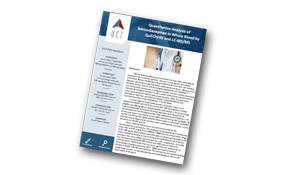This application from UCT describes an easy, fast, and effective method using QuEChERS for the quantitative analysis of benzodiazepines in whole blood.
 Introduction
Introduction
Benzodiazepines (Benzos) are psychoactive drugs widely prescribed for treating anxiety, insomnia, agitation, seizures, muscle spasms, and alcohol withdrawal. Benzos are deemed safe and effective for short term use. However, frequent use of these drugs may lead to dependence and abuse. Because of this attribute, clinical, forensic and toxicological laboratories are interested in monitoring these compounds in biological samples. Common sample preparation methods for biological samples include a protein precipitation step followed by liquid-liquid extraction (LLE) or solid phase extraction (SPE). This application describes an easy, fast, and effective method using QuEChERS for the quantitative analysis of benzodiazepines in whole blood.
Method
1 mL of negative whole blood sample is extracted using 2 mL of acetonitrile (MeCN) with 0.4 % formic acid (FA). 400 mg magnesium sulfate (MgSO4) and 100 mg sodium acetate (NaOAc) (pre-packed in 15-mL centrifuge tube) are employed to enhance the phase separation and the partition of benzodiazepines into the organic phase. After shaking and centrifugation, 1 mL of the supernatant is purified by a 2-mL dSPE tube containing 150 mg MgSO4, 50 mg PSA, and 50 mg C18. MgSO4 absorbs residual water in the extract, while PSA and C18 remove organic acids and fatty matrix co-extractives, resulting in a clean extract for LC-MS/MS analysis.
Matrix matched calibration curves were constructed for the benzodiazepines quantification. The responses for 10 representative compounds were linear with R2 ranging from 0.9963 to 1.0000 over the concentration range of 10–500 ng/mL. Matrix effects were evaluated by comparing the slopes of the
matrix matched calibration curves to those of the calibration curves of solvent standards.
Conclusion
The matrix effects were found to be minor, ranging from -22 to 18%. This indicated that the QuEChERS method with dSPE cleanup sufficiently removed matrix interferences that may cause significant ion suppression or enhancement. Excellent recoveries (85.5–105%) and relative standard deviations (RSD% ≤ 10.7%) were obtained. This method was also applied to 8 real whole blood samples, no benzodiazepines were detected above the limit of quantitation of 10 ng/mL.
For full details of experimental conditions and results download the application note.
